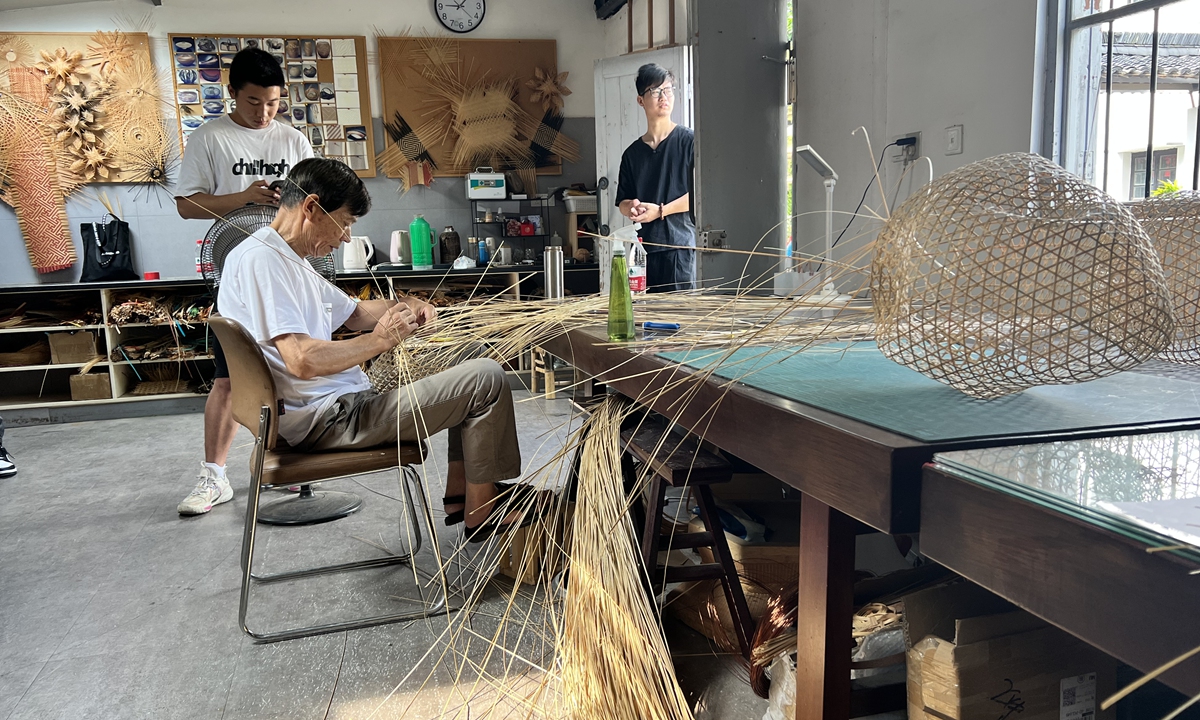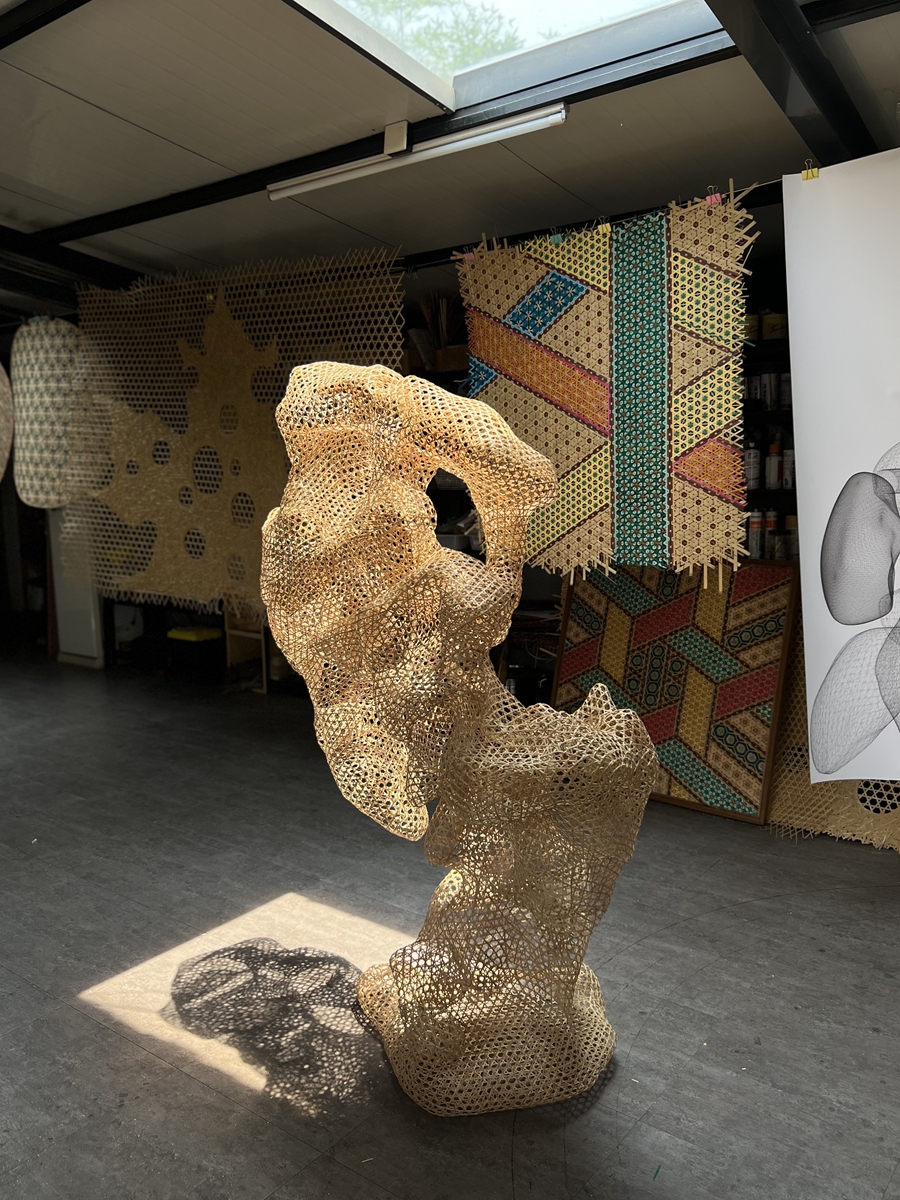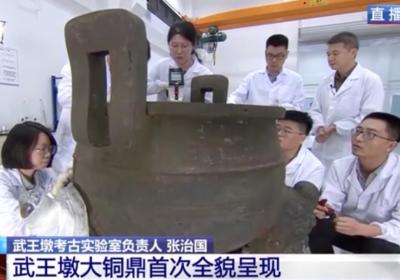
Craftsmen work on bamboo weaving handicrafts in Wuzhen, East China's Zhejiang Province. Photo: Pang Yue/Global Times
In the watery villages along the southern part of the Yangtze River, bamboo is a major part of people's daily life. Before Wuzhen, a village in East China's Zhejiang Province, became famous for tourism and the World Internet Conference, it was a major handicraft town with a centuries-old history of bamboo weaving.
Since the Ming Dynasty (1368-1644), Wuzhen bamboo weaving has made a name for itself. At that time, several craftsmen from Wuzhen were invited to serve at the imperial court. Later, the number of practitioners, bamboo ware houses and factories in the small town boomed. Bamboo weaving as a trade thus became one of Wuzhen's long-term labels.
However, the nationwide rise of plastic products in the late 1990s marginalized the bamboo weaving industry. The widespread use of plastics led to the complete closure of bamboo factories, and the historical status of bamboo products was then quickly replaced.
Means to surviveAn inheritor of bamboo weaving, Qian Jihuai recalled to the Global Times that the handicraft in Wuzhen was rapidly declining at that time.
Between 1985 and 1993, Wuzhen's bamboo weaving industry witnessed its last massive boom, Qian said. At that time, there were at least 400 households in the village dedicated to bamboo weaving. Craftsmen wove bamboo into a variety of daily necessities and sold them to buyers all over the country.
Now, however, only about 20 families in the town are still engaged in bamboo weaving, as demand for daily necessities made from bamboo has continued to shrink, Qian said.
What we're about to tell is not a conventional story of "Renaissance." It does not end with a historical legacy finally triumphing over the "soulless modern industrial assembly line." However, Qian has indeed found a way to keep it going.
In 2007, Qian, at the age of 27, quit his job working for a company and followed his father, Qian Xinming, to engage in bamboo weaving full time. At that time, it was the era of the decline of bamboo weaving in Wuzhen so his father was always considering ways to make a living with the craft.
He came up with the idea of linking bamboo weaving with Wuzhen's tourism industry. He applied for a store at a tourist attraction and then tried to weave some Chinese characters out of bamboo as tourist souvenirs. It turned out that tourists loved these novel souvenirs.
Qian and his father therefore saw this as a new path to promote bamboo weaving and began developing related products. They traveled to other towns in China with a tradition of bamboo weaving and studied and researched extensively on the development of bamboo weaving in other countries.
"We gradually discovered that there was a lot of room for the expansion of bamboo weaving as an art," Qian said.

A bamboo weaving decoration Zhuyun Workshop Photo: Pang Yue/Global Times
Introducing innovationAlthough these non-traditional bamboo weaving products have proven successful, the Qians have encountered many difficulties during this transition.
Bamboo weaving is a craft in which craftsmen are the most important element, Qian said. However, there were few workers who are able to combine decorative artistic elements in bamboo weaving.
"Most of the craftsmen in the village who were engaged in bamboo weaving were elderly people. They were used to weaving everyday items and their skills were rather crude," Qian said.
"It was difficult for them to make the transition to artistic bamboo weaving."
In addition, although bamboo weaving has a long history, Qian had no access to systematic knowledge, let alone scholars.
"In the entire province, there were only five books on bamboo weaving that I could borrow from the library," he said.
"And the internet was not well developed at that time, if you wanted to learn about non-traditional bamboo weaving, you could only go out into the field."
The plight made Qian more determined than ever to train more talent, as well as archive Wuzhen bamboo weaving techniques and historical heritage, so that no one would have to go through the difficulties he had encountered.
When Wuzhen bamboo weaving was named as an intangible cultural heritage of the city in 2010, the related departments involved were surprised by the innovations that the Qian family had introduced. Some officials even recommended the Qians' bamboo weaving artworks to various exhibitions.
During the 2nd Wuzhen Internet Conference in December 2015, Wuzhen bamboo weaving was presented at the press reception dinner, receiving great attention from global media. Exquisite Wuzhen bamboo weaving was thus brought to the world stage.

A bamboo weaving handicraft at the Zhuyun Workshop Photo: Pang Yue/Global Times
Good enoughAs Wuzhen bamboo weaving was rising to an art form, Qian stuck to his ideals.
He set up his own bamboo weaving studio with his father and brother, brought systematic bamboo weaving classes to schools, and introduced bamboo weaving skills to more people through online livestreams. In his studio, the Zhuyun Workshop, 15,000 visitors study bamboo weaving and take part in learning experiences every year.
Qian, however, refuses to idealize the future of Wuzhen bamboo weaving. When he entered the industry more than a decade ago, he felt that a gradual decline was the future of bamboo weaving. In 2023, his thoughts on the matter remain unchanged.
"Mass production is out of the question," he said.
"Those bamboo products that were historically common are no longer needed. If some new products emerge that need to be produced through mass manufacture, this goes against the history of bamboo weaving. Traditional bamboo weaving has lost the soil on which it was built."
So what is the point of all this effort?
"It's not very realistic to say that we're going to develop a lot of bamboo weaving talent or to drive a lot of people into the industry," he told the Global Times.
"While we, and the craft of bamboo weaving will survive, we'll probably only help a small number of people make a living, and that's good enough for me."
"Even though there may be fewer real bamboo weaving practitioners, and even people who pay attention to bamboo weaving because of momentary media exposure may leave, this historical legacy of bamboo weaving will not die out," Qian said. "I have learned that we Chinese are born with the feelings for bamboo and bamboo weaving art. The feelings are inherent."








